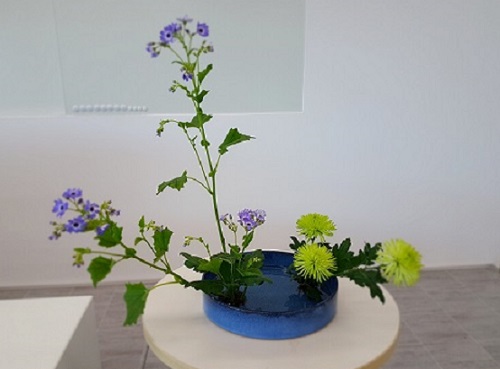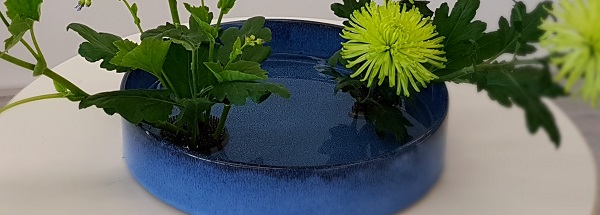Getting back into ikebana after a 20-day hiatus wasn’t easy. Like any skill-development abandoned for a significant period of time—exercise, music practice, that golf swing, whatever—there’s a certain muscle tone and mindset which deteriorates in the interval.
Plus, I sensed that with the flip of the calendar the bar of expectation had been raised. Though I still feel a raw beginner with a less-than-perfect skill set or knowledge of the materials, I got the sense that the teachers no longer saw it that way.
In that slack time I’d also lost some dexterity that I’d achieved in that delicate dance we Westerners often must do around Japanese pedagogy. That’s not helped by the fact that different teachers rotate through the schedule once a month.

An arrangement using two kenzan.
The marvel of the rotating schedule is that students are exposed to numerous master teachers, as well as a variety of styles and approaches to the design elements rather than studying many years with only one.
On the other hand, after two previous meetings in a class of 35 to 40 others, the teachers don’t know me. They may not remember that I have yet to complete Level Two. Even so, it’s more than obvious that I am not Japanese and do not understand the language.
However, the first day back it seemed as if no one quite understood how green and unskilled I am. How did you imagine that I knew this? I wondered more than once.
The two or three teacher assistants who translate for the Tuesday and Thursday Iemoto classes are there more frequently and know my capabilities a little better. However, at times they can offer contradictory advice. One will say, do this; another will come by and advise, do that.

The space across the water
In addition, I’m pushing myself hard as I wish to complete Level Two before leaving. Therefore, on Tuesdays and Thursdays I am taking three two-hour classes. I finished the last week of 2017’s term quite energized doing that, but starting 2018 that way proved more problematic than I’d expected.
When we returned on Thursday the first and second lessons went well. However, on the day’s final lesson I forgot the fundamental rule of all instruction: Read the directions. All of them. Somehow I’d overlooked the second column above the photograph. My bad.
In addition, I forgot about the Japanese yes. I had asked if a certain flower would be suitable for the next variation on my schedule. The teacher assistant said yes. It’s probably true. Any experienced teacher would have known how to handle that flower.

Sakura branches and chrysanthemums
But what I forgot in the excitement of returning to class was the cultural inclination of Japanese people not to say no. What I ought to have asked is this: If I choose this flower for this arrangement, are there any problems I could encounter or any tricks I should know? The answer to that was yes and oh yes.
And finally, seconds before our working time was up, I was offered last-minute advice from a teacher assistant concerning the significant flaw in my work. On receiving the advice, it seemed to me that she wanted to rapidly pull the arrangement apart and perfect it before the master teacher offered a final evaluation. A sort of “let me rescue you and make it right” pedagogy.
Though I had to be insistent, I respectfully declined. I refuse to work that way. Short of a disaster requiring an immediate response to save my life or a quick lunge to catch a glass about to spill the wine, I never do a mad scramble for anything.
It’s a flower arrangement. If it’s wrong, it’s wrong. I’ll note the flaws. I’ll repeat it before progressing to the next lesson if need be. I’ll be more aware and do better on the next one. That’s the inescapable essence of the learning process. Moreover, if someone else fixes it for me, it’s not my work. Any evaluation of it counts for nothing. Give me a B or even C minus on something that’s mine over an A plus on something which is not.
Besides, the master teacher for the day was one who routinely pulls everyone’s work apart. She’s magnificent. She offers bang-on feedback, and her adjustments always improve the design. However, no one is spared from snipped, flipped or extracted bits. In that instance, all logic dictated that any mad attempt to perfect something at the last minute was pointless.
I was quite right. That’s exactly what she did–ripped things out, cut them off and arranged them into greater harmony. Alas, even she couldn’t make anything worth photographing out of it.
Live and learn. Oh yeah, and repeat after me: Read the directions. All of them.
